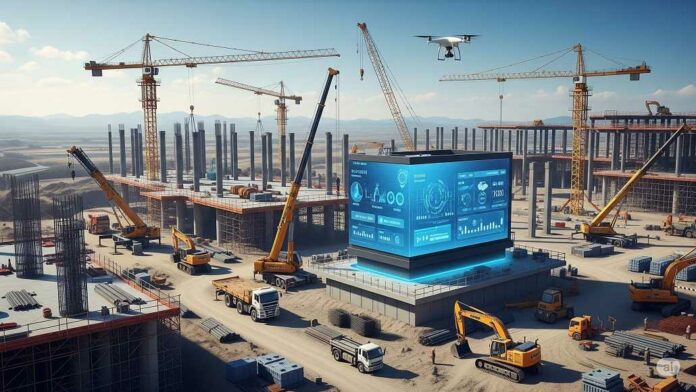The heavy and civil engineering construction global market in 2025 happens to stand as a backbone when it comes to economic development by underpinning the vital infrastructure, which helps with trade, energy, transport, and communication systems throughout the regions. Known for large-scale projects, ranging from bridges and highways to power lines and pipelines, this sector continues to evolve in the middle of rising urbanization, population spurts, and also government investments. With a worldwide market all set to climb from somewhere around $2100 billion in 2025 to $2500 billion by 2029, the industry goes on to reflect resilience along with an immediate requirement for innovation due to material costs, shortages of labor, and demands for sustainability.
Market landscape along with growth outlook
It is well to be noted that the worldwide market for heavy and civil engineering construction grew from $2000 billion in 2024 to around $2100 billion in 2025, thereby marking a compound annual growth rate (CAGR) of almost 4%. This kind of momentum is anticipated to persist with a CAGR of roughly around 4.7% all through 2029, therefore making way for a market size of almost $2570 billion.
Growth in 2025 is driven mainly due to sustained economic expansion, especially within emerging markets where faster urbanization along with industrialization has fueled the requirement for new infrastructure. Government initiatives throughout regions are also paving the way and indeed playing a very critical role in funding civil infrastructure, specifically within transport, energy, and sanitation projects. Strategic partnerships between public agencies as well as private contractors are expanding the scale along with the speed of implementation.
What are the core categories in focus?
When we talk of market segmentation, heavy and civil engineering construction happens to be widely segmented into utility system construction, highway, street, and bridge construction, as well as other specialized segments. Each vertical happens to be deeply integrated within the broader functioning of economies, thereby needing specialized planning along with technical expertise and also resource-intensive implementation.
It is worth noting that utility system construction happens to encompass infrastructure for water, petroleum, sewer, gas, electricity, and communication systems. This happens to include distribution lines, storage tanks, pumping stations, and even power plants along with refineries. As the global energy demand goes on to intensify and the governments modernize their aged utility framework, this segment happens to remain a focal point when it comes to funding.
Highway street and bridge construction is also gaining a lot of ground and traction, which is supported due to both public works programmes along with private sector development across emerging economies. There are many regions where improvement in road connectivity is no longer a luxury, but it is a necessity because of trade and mobility.
These projects get managed by a range of entities, right from large enterprises having regional or global footprints to smaller and medium-sized enterprises that specialize in niche construction services. Both public as well as private sector contracts happen to form the foundation of demand and offer revenue stability across industry players.
Regional performance and the leading economies
Interestingly, Asia Pacific emerged as the largest contributor when it comes to the global market in 2024, and that leadership still continues in 2025. Infrastructure mega projects in countries such as Indonesia, China, India, and Vietnam are being spurred due to government urban expansion along with the development of industrial corridors.
Notably, North America happens to rank as the second largest region, which is supported due to infrastructure revitalization programs across the countries of Canada and theUnited States. The erstwhile Biden administration’s infrastructure agenda, teamed with the growing construction activity within renewable energy as well as transport, bolstered North America’s presence within the global rankings.
Interestingly, Europe as well as the Middle East are showing moderate growth, mostly shaped by green infrastructure initiatives, energy transition endeavors, and sustainable city planning. Africa, as well as Latin America, though smaller when it comes to market share, is gaining some momentum due to new regional trade corridors along with transmission projects that are currently underway.
The macroeconomic drivers
In 2025, the expansion when it comes to the heavy and civil engineering construction global market happens to be closely tied to macroeconomic health. Economic growth goes on to foster government spending, raises the investors’ confidence, and also speeds up the public-private partnerships, which are all critical to funding the infrastructure. For instance, the 2.4% real GDP growth within the US in the second quarter of 2023, as reported by the Bureau of Economic Analysis, went over to set a precedent for continuous infrastructure demand going into this year.
Moreover, fast urbanization along with population growth across developing countries has gone on to create mounting pressure on cities in order to expand their utility, transportation, and housing infrastructure, thereby making heavy civil projects very critical to the development agenda of any nation.
Trends in innovation and technology
Technological advancement happens to be playing a transformative role when it comes to the revolution of heavy and civil engineering construction. In 2025, firms are growingly turning towards digital solutions in order to lessen the risks, bloat up the efficiency, and also drive productivity.
The key trends include –
Drone technology – which facilitates real-time error, aerial mapping, inspection, and even surveillance.
3-D printing – offering fast prototyping as well as reduced waste when it comes to concrete construction.
Building Information Modelling – BIM – elevating the planning, accuracy, detection of clashes, and even project coordination.
AI as well as software integration – enabling to manage schedules, budgeting, and also resource allocation in a more efficient way.
One of the notable examples happens to be Topcon Positioning Systems, Inc., which in April 2023 went on to launch the digital layout platform. This kind of software goes on to integrate with robotic layout instruments, enabling the contractors ranging from general to MEP specialists so that they could streamline digital construction workflows. Such kind of innovation is indeed closing the gap between the erstwhile traditional construction practices and the next generation of digital tools.
In the end
The Heavy and Civil Engineering Construction Global Market Report 2025 goes on to reveal that this industry is certainly in expansion mode and is driven due to economic growth, urbanization, and also infrastructure investments throughout the world. The market is expected to reach somewhere around $2500 billion by 2029, and the path ahead is both full of promise as well as challenge.
The material cost as well as labor shortages are continuing to test profit margins. Technological innovation, digital project management tools, and equipment Modernization is all reshaping how the infrastructure is getting constructed. The capacity of companies to digitize, adapt, and also roll out complex projects in an efficient form is going to determine their resilience in a landscape that is already globally competitive.
In summary, heavy and civil engineering is not only about constructing the physical world, but it is more about laying the foundation for communities, economies, and also technologies when it comes to the future.





























